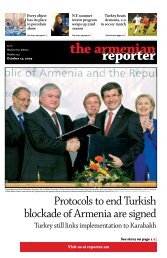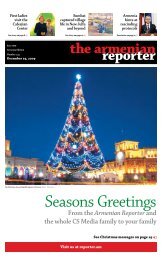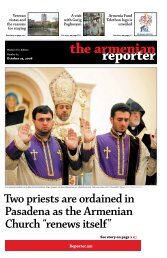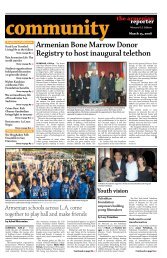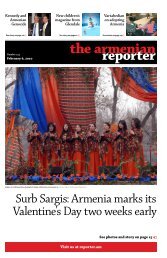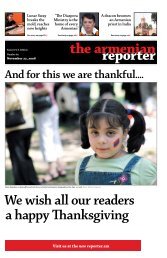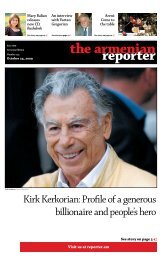And for this we are thankful.... - Armenian Reporter
And for this we are thankful.... - Armenian Reporter
And for this we are thankful.... - Armenian Reporter
You also want an ePaper? Increase the reach of your titles
YUMPU automatically turns print PDFs into web optimized ePapers that Google loves.
The <strong>Armenian</strong> <strong>Reporter</strong> | November 22, 2008InternationalSettling the Nagorno-Karabakh conflict:ProposalOutcomeNagorno-Karabakh (Artsakh)Territory andpopulationStatusCitizenshipArmenia–Nagorno-KarabakhpassageAzerbaijan-NakhichevanpassageStatus quo ante (from1921–23 to 1988–91)1[imposed by Stalinand the USSR]Nagorno-Karabakh AutonomousRegion, a self-governing entitywithin the Azerbaijani Soviet SocialistRepublic within the Unionof Soviet Socialist Republics2The Nagorno-KarabakhAutonomous Regionoccupied 4,400 sq kmand had a population ofabout 190,000 in 19893Citizens of SovietAzerbaijan and theUSSRSeparated by Lachin, 7 km at itsnarro<strong>we</strong>st4Free movement overArmeniaStatus quo (since thecease-fire of May 12,1994)[As a result of war,Karabakh took controlof more than7,000 sq km of additionalterritory.]Republic, decl<strong>are</strong>d in 1991, and notrecognized by any country, includingArmenia.Over 11.5 thousandsq km, of which about7,000 sq km <strong>are</strong> sevendistricts of AzerbaijanNo internationallyrecognized citizenship;carry passportsof the Republic ofArmenia.Free passage over four routes:the Goris-Lachin-Shushi-Stepanakerthighway, Sotk-Kelbajar-Martakert,Goris-Kubatly,Kapan-ZangelanLand passage is carriedout over IranRussian-brokereddocument, June–November 1994Superceded by December5–6, 1994Buch<strong>are</strong>st summit.7No mention of status“Package option”:“ComprehensiveAgreement on theResolution of theNagorno-KarabakhConflict,” July 1997.Rejected by the<strong>Armenian</strong> side“Nagorno-Karabakh is a state and 4.4 thousand sq km and “Nagorno-Karabakhterritorial entity within Azerbaijan” the Lachin corridor (underOSCE supervision) Azerbaijani passportscitizens will havewith the special annotation,‘Nagorno-Karabakh.’”“Azerbaijan leases the corridorto the OSCE, which will sign anagreement to provide it <strong>for</strong> theexclusive use of the Nagorno-Karabakh authorities.”“Stage-by-stage0ption”: “Draft Agreementon Ending theNagorno-KarabakhConflict,” December1997Rejected byNagorno-KarabakhNo mention of status. Deals exclusivelywith consequences.4.4 thousand sq kmand the Lachin district(1,835 sq km)Not covered.“Nagorno-Karabakh <strong>for</strong>ces <strong>are</strong>brought inside the 1988 boundariesof the Nagorno-KarabakhAutonomous Region, except inthe Lachin district.”“Common State”: “On Rejected by Azerbaijanthe principles <strong>for</strong> acomprehensive resolutionof the Nagorno-Karabakh conflict,”November 1998.“Nagorno-Karabakh is a state andterritorial entity in the <strong>for</strong>m of <strong>are</strong>public and with Azerbaijan comprisesa ‘Common State’ withinits internationally recognizedborders.”4.4 thousand sq km andthe Lachin corridor“As identificationdocuments, citizensof Nagorno-Karabakhwill have Azerbaijanipassports with thespecial annotation‘Nagorno-Karabakh.”“The question of the use of theLachin corridor by Nagorno-Karabakh to provide <strong>for</strong> unfetteredpassage bet<strong>we</strong>en Nagorno-Karabakhand Armenia issubject to a separate agreement.”Paris–Key West “unofficial”proposal,spring 2001Rejected by AzerbaijanNagorno-Karabakh, along with theLachin corridor, becomes a sovereignterritory of Armenia.Citizens of Armenia Sovereign <strong>Armenian</strong> territory Azerbaijan receives a“sovereign passage” toNakhichevan throughthe south of Armenia.Prague-Madrid principlesCurrently underconsiderationInterim status recognized; finalstatus to be determined by referendumor plebiscitePrep<strong>are</strong>d by Tatul Hakobyan <strong>for</strong> the <strong>Armenian</strong> <strong>Reporter</strong>. November 20, 2008.4.4 thousand sq km andthe Lachin corridor;also Kelbajar until referendum/plebisciteorinterim statusInterim statusNarrow passageMediators play down prospects of early Karabakh settlementn Continued from page <strong>for</strong>mat, was rejected by <strong>Armenian</strong>sthrough Stepanakert.In December of the same year,the mediators presented a “stageby-stage”proposal (addressing securityissues and the consequencesof the conflict immediately andleaving the status of Nagorno-Karabakh’s open to an unspecifiedfuture date). This proposal, whichwas accepted with serious reservationas a basis <strong>for</strong> negotiations byPresident Levon Ter-Petrossian,led to his resignation.A year later, in November 1998,the OSCE Minsk Group presentedthe “common state” proposal,which was accepted by Yerevan andStepanakert with some reservations;Baku rejected it. Azerbaijanalso rejected the Paris-Key Westproposal in the spring of 2001.With the rejection of successivedraft agreements by one side oranother, the OSCE Minsk Groupco-chairs adopted a new approach.They held series of separate andjoint talks with the <strong>for</strong>eign ministersof Armenia and Azerbaijan,known as the Prague process. Then,in August 2005, they presentedPresident Robert Kocharianof Armenia and Mr. Aliyev with aone-page statement of principlesaround which they sought to securethe agreement of the <strong>Armenian</strong>side (Armenia and Nagorno-President Heydar Aliyev of Azerbaijan, left, with U.S. Secretary of State ColinPo<strong>we</strong>ll and President Robert Kocharian of Armenia in 2001. Photo: Photolure.Karabakh) and the Azerbaijaniside. Only after the framework wasagreed to would negotiations overa settlement agreement begin.Moreover, if in the past the mediatorsprep<strong>are</strong>d the proposals<strong>for</strong> the consideration of the parties,now the majority of the workwas done by the <strong>for</strong>eign ministers.This method was meant to give thesides a greater stake in the resultingdocuments and make it moredifficult <strong>for</strong> the parties to reject theoutcome out of hand.As in the past, the negotiations<strong>are</strong> confidential. Ho<strong>we</strong>ver, the announcements,statements of concern,objections, and at times thedeliberate leaking of in<strong>for</strong>mationby the parties, the mediators, anddifferent international organizationsgive us the opportunity topresent the principles that <strong>are</strong>currently on the negotiating tableand <strong>are</strong> being called the MadridPrinciples. Madrid is where, exactlya year ago, the <strong>for</strong>eign ministersof Russia and France, SergeyLavrov and Bernard Kouchnerand U.S. Deputy Secretary ofState Nicolas Burns presented athree-page document to the <strong>for</strong>eignministers of Armenia andAzerbaijan.The main difference bet<strong>we</strong>en the2005 Kazan and 2007 Madrid documentsis that as negotiations havecontinued, issues, concerns, andsticking points have emerged; themediators have set <strong>for</strong>th proposedsolutions, and a one-page proposalhas morphed into a three-page proposal.Ho<strong>we</strong>ver, the four core principlesaround which Yerevan and Baku<strong>are</strong> negotiating have been preserved.Let us present the four mainprinciples.First: The status of Nagorno-Karabakh will be decided thougha referendum or a plebiscite at atime to be determined later. Participationin the referendum or plebiscitewill reflect the demographicpicture of the <strong>for</strong>mer Nagorno-Karabakh Autonomous Region, asit was prior to the beginning of thewar in 1991.It is evident to all parties that thechances that a new referendum willactually be held <strong>are</strong> very slim. Butit is very important <strong>for</strong> the <strong>Armenian</strong>side, specifically Yerevan, <strong>for</strong>Baku to agree (which it so far refusesto do) that the status of Nagorno-Karabakhis a matter to bedecided by referendum – a matterof self-determination. This pointcontinues to be a sticking point inthe negotiations.Second: Until Nagorno-Karabakh’sfinal status is determined,Baku and the international communitywill recognize that Nagorno-Karabakhhas an “interim status.”The interim status would rein<strong>for</strong>cetoday’s status quo, except inthe regions of Kubatly, Jebrail, andZangelan, and the parts of Fizuliand Aghdam that <strong>are</strong> under <strong>Armenian</strong>control.Third: The return of the territoriesunder Karabakh’s controlwill be carried out by a 5+1+1 (Kubatly,Jerbrail, Zangelan, Fizuli,and Aghdam + Kelbajar + part ofLachin) <strong>for</strong>mula. In other words,the stage-by-stage method is to beused <strong>for</strong> the return of the territories.The issue of the five regionsis certain. The return of Kelbajarwill be linked to the implementationof the referendum or, alternatively,to the recognition of theinterim status. As <strong>for</strong> the Lachinregion, some parts of it would bereturned, and a corridor wouldremain within the borders of Nagorno-Karabakhas a land link toArmenia.Fourth: This principle concernssecurity guarantees.The Madrid Principles <strong>are</strong> inmany ways similar to the stage-bystageproposal of 1997, where thefinal status of Karabakh is left tothe future. Ho<strong>we</strong>ver, in contrast tothe 1997 stage-by-stage proposal,<strong>this</strong> proposal could be called a <strong>for</strong>eseeablestage-by-<strong>for</strong>eseeable stageproposal.f



